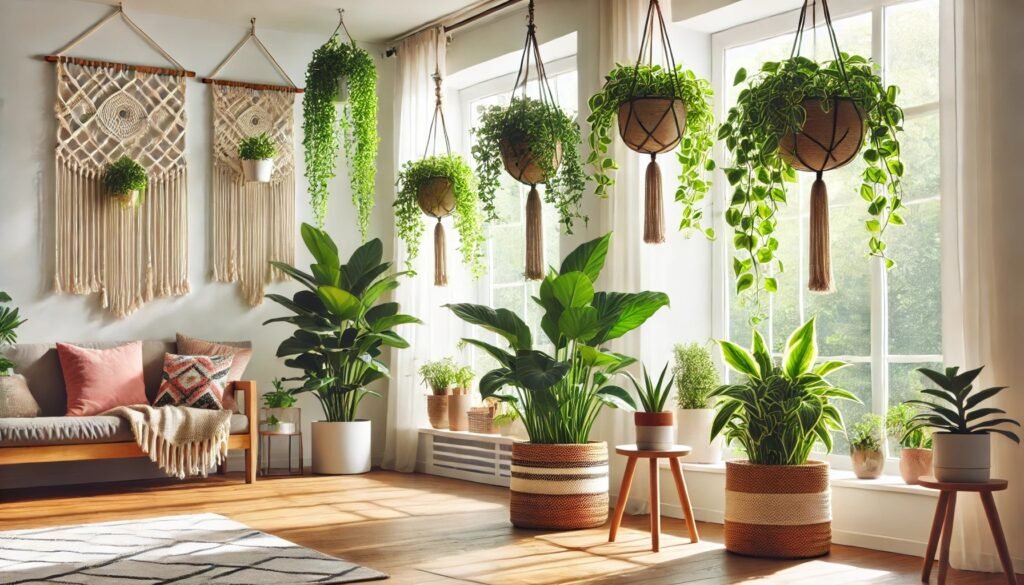
Indoor plants bring life and color to our homes, but just like any living thing, they need a little maintenance to thrive. Pruning and harvesting are essential practices that help keep your houseplants healthy, vibrant, and looking their best. In this guide, we’ll walk through the essential steps for pruning and harvesting the top ten most common indoor houseplants. We’ll explore the right tools to use, when and how to prune, and how to adjust care routines before and after pruning.
Tools for Pruning Indoor Plants
Before diving into the specifics of each plant, let’s start with the tools you’ll need. Proper tools ensure clean cuts, which help prevent damage and disease.
- Sharp Pruning Shears: Essential for making clean cuts on thicker stems.
- Scissors: Ideal for lighter, more delicate trimming.
- Sterilizing Wipes: To clean your tools before and after use, reducing the risk of disease.
- Gloves: Protect your hands from sap and thorns, especially with plants like succulents.
Now that you’re equipped with the right tools, let’s delve into how to care for the ten most common indoor houseplants.
Fiddle Leaf Fig: The Statement Plant
Fiddle Leaf Figs are famous for their broad, shiny leaves, but they can grow unruly if not pruned regularly.
Pruning Tips:
- When to Prune: Late spring or early summer, when the plant is actively growing.
- How to Prune: Cut just above the node (the point where the leaf meets the stem). This encourages branching and a fuller plant. Remove any dead or damaged leaves immediately.
- Water and Fertilizer: Reduce watering slightly after pruning to help the plant recover. Keep fertilizer consistent, applying it every 4-6 weeks during the growing season.
Monstera Deliciosa: The Swiss Cheese Plant
Monstera plants are known for their unique, holey leaves. Pruning helps manage their size and encourages new growth.
Pruning Tips:
- When to Prune: Best done in spring or summer.
- How to Prune: Cut just above a leaf node to promote bushier growth. Remove yellowing or damaged leaves as they appear.
- Water and Fertilizer: Continue with regular watering, but you might slightly reduce the amount after pruning. Fertilize once a month during the growing season.
Spider Plant: The Easy-Going Air Purifier
Spider Plants are low-maintenance and produce “”babies”” or offshoots that can be pruned and propagated.
Pruning Tips:
- When to Prune: Anytime during the growing season, but ideally in spring.
- How to Prune: Trim offshoots close to the base to encourage the main plant’s growth. Remove any yellow or brown tips on the leaves to keep the plant looking fresh.
- Water and Fertilizer: Maintain regular watering; Spider Plants are resilient and won’t need a change. Continue fertilizing every 2-3 months.
Peace Lily: The Elegant Bloomer
Peace Lilies are prized for their white blooms, and proper pruning keeps them healthy and encourages more flowers.
Pruning Tips:
- When to Prune: After the flowers fade, typically in late spring or summer.
- How to Prune: Cut the flower stems down to the base of the plant. Remove any yellowing or damaged leaves to keep the foliage lush.
- Water and Fertilizer: Reduce watering slightly after pruning and continue with regular fertilization every 6 weeks during the growing season.
Snake Plant: The Sturdy Survivor
Snake Plants are nearly indestructible, but they benefit from occasional pruning to remove dead or damaged leaves.
Pruning Tips:
- When to Prune: Anytime during the year, but ideally in spring or summer.
- How to Prune: Cut leaves at the base, removing them entirely. Snake Plants grow slowly, so don’t over-prune.
- Water and Fertilizer: No need to change the watering schedule. Fertilize sparingly, about every 2-3 months.
Pothos: The Trailing Beauty
Pothos is a versatile plant that can trail or climb. Pruning helps control its shape and encourages fuller growth.
Pruning Tips:
- When to Prune: Best done in spring or summer.
- How to Prune: Cut just above a leaf node, especially if you’re trying to encourage a fuller appearance. Remove any leggy or yellowing vines.
- Water and Fertilizer: Keep watering as usual. Fertilize every 4-6 weeks during the growing season.
Rubber Plant: The Bold Foliage Favorite
Rubber Plants have striking, glossy leaves, and pruning can help control their height and shape.
Pruning Tips:
- When to Prune: Spring or early summer.
- How to Prune: Cut just above a leaf node to encourage branching. Remove any lower leaves if you want a more tree-like appearance.
- Water and Fertilizer: Slightly reduce watering after pruning. Continue fertilizing once a month during the growing season.
ZZ Plant: The Low-Light Wonder
ZZ Plants thrive in low light and require minimal care. Pruning helps remove dead leaves and control their shape.
Pruning Tips:
- When to Prune: Any time of the year, but spring is ideal.
- How to Prune: Remove yellow or dead leaves at the base of the stem. Cut stems that are too long or leggy to encourage new growth.
- Water and Fertilizer: Continue with your usual watering routine. Fertilize every 2-3 months.
Boston Fern: The Classic Hanging Plant
Boston Ferns are lush and full but can become unruly without regular pruning.
Pruning Tips:
- When to Prune: Late winter or early spring, before new growth begins.
- How to Prune: Trim back any dead or discolored fronds at the base. Regularly remove dead fronds to keep the plant healthy.
- Water and Fertilizer: Maintain regular watering. Increase humidity if possible. Fertilize monthly during the growing season.
Jade Plant: The Succulent Beauty
Jade Plants are slow growers but can become top-heavy without proper pruning.
Pruning Tips:
- When to Prune: Spring or early summer.
- How to Prune: Cut just above a leaf node to encourage branching. Remove any dead or shriveled leaves to keep the plant looking its best.
- Water and Fertilizer: Reduce watering slightly after pruning, as succulents don’t need much water. Fertilize sparingly, every 3-4 months.
General Care After Pruning
After pruning your plants, they may need a bit of extra attention to recover. Here’s how to help them bounce back:
- Watering: Most plants will benefit from slightly reduced watering after pruning. This allows the plant to focus its energy on healing rather than growing.
- Fertilizing: Continue with regular fertilization, but avoid over-fertilizing, as this can stress the plant.
- Light: Ensure your plants are getting adequate light, especially after pruning. They need the energy to produce new growth.
Wrapping It Up
Pruning and harvesting your indoor houseplants is more than just a maintenance task—it’s a way to connect with your plants and ensure they remain healthy and beautiful for years to come. By understanding each plant’s specific needs and timing your pruning sessions appropriately, you’ll enjoy lush, thriving indoor greenery all year long. Remember to use clean tools, make thoughtful cuts, and adjust your care routine as needed to help your plants recover and flourish.
Happy gardening!
Stay connected with the world of plants! Subscribe to Phylofy for expert gardening tips, DIY projects, and eco-friendly inspiration. Join our community and nurture your love for nature. Don’t miss exclusive content and updates. Subscribe now!



